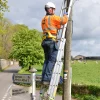Persimmon Sues BT Over Unpaid Bill for New Homes Infrastructure
House builder Persimmon has launched a lawsuit against BT (Openreach), which accuses the UK telecoms giant of allegedly owing them £7.2m plus interest for unpaid work as part of deploying new broadband ISP and phone infrastructure on 759 of its developments between 2008 and 2016.
Under the current Universal Service Obligation (USO) BT are required to deliver, following the “reasonable request of any End-user” (i.e. demand-led), a telephone service that includes the ability to offer “data rates that are sufficient to permit functional internet access” (here). For the most part this results in people gaining access to a basic copper broadband line (technically they could get away with only supporting narrowband dialup), provided the costs stay within a threshold.
Naturally this is something that new home builders also had to factor as part of the old agreement with BT. Traditionally many of the developers would lay some of the necessary infrastructure and then Openreach would come in to inspect the work, before paying the property developer for any bits that it is obligated to cover.
Advertisement
All of this began to change in 2016 as part of a new agreement between Openreach and the Home Builders Federation (HBF) to help expand faster “fibre broadband” (FTTC / FTTP) based services (here). Since then Openreach has also started to offer either significantly cheaper or completely free Fibre-to-the-Premises (FTTP) lines to most new home developments (here).
However Persimmon’s lawsuit reflects the old agreement via a period that ran from 2008 to 2016, which we assume would be connected to the original USO requirements rather than newer “fibre” based services (the publicly available details are somewhat vague).
The case simply claims that BT “frustrated the process of inspection and certification.” The operator is said to have breached the contract by failing or refusing to inspect the installation, certify its quality or pay invoices. Persimmon is seeking £7.2m plus interest from the operator. All of this is perhaps a touch ironic since Persimmon has similarly faced complaints from some home owners over the quality of their new builds.
We should point out that the existing USO is due to be replaced later this year with a new 10Mbps+ minimum broadband speed requirement (here), which is expected to focus on the final 2-3% of UK premises (around 600,000) that have not gained access to a “superfast broadband” (24Mbps+) connection by 2020.
Advertisement
Mark is a professional technology writer, IT consultant and computer engineer from Dorset (England), he also founded ISPreview in 1999 and enjoys analysing the latest telecoms and broadband developments. Find me on X (Twitter), Mastodon, Facebook, BlueSky, Threads.net and Linkedin.
« Challenges Remain as Openreach Improve UK Cable Duct and Pole Access UPDATE


















































OR provides the duct, frames etc along with the specifications for the builder’s ground contractor free of charge and then pays an agreed HBF payment. I interpret “frustrated the process of inspection and certification.” as the civils not being to the standard or in a status available to inspect. It will transpire whether OR are at fault or not but the same would apply to building regulations and other services. The dates imply FTTC would have been the default technology provided by BT.
There is currently no USO for broadband only telephony and the future one will not be applicable to new build as developers are responsible to select a provider. If they choose an Altnet BT no longer has the telephony obligation.
New Build is notoriously difficult as Altnets will now find although they may be able to flex more readily when plans change.
It appears during this period that Persimmon built many developments and declined offers for FTTC or VM. So many new homes left with ADSL which would have met the “permit functional internet access” requirement but was not what the new home owners had been led to expect. There is also anecdotal evidence on the the internet of people moving in and not being able to get telephony/broadband as the duct (and their paths) had not been completed to the house. OR would quite rightly withhold payment if they could not complete their cabling to the houses.
More money for the lawyers.
I hope OR’s case is robust. £7m = over 14,000 FTTP.
“£7m = over 14,000 FTTP”
Is that based (by my calculation anyway) on you assuming £500 per property?
If it is why are they charging 10’s of thousands for FTTP/FTTPOD installs?
As for the complaint there is not enough detail, there has previously been stories of new builds having no phone and/or internet access (including ADSL) for months on this site after people have moved in.
Although according to the very letter of regulation DialUp internet is classified as internet access i doubt that if challenged in a court, especially when the organisation concerned (Openreach) has allegedly not paid for work the house builder done, that Dial Up would be deemed as functional by any judge that has any technical understanding of such things. Then again i doubt based of some of the decisions what seem to happen in civil and criminal cases in this country there are many judges which do have enough knowledge in these matters.
Ultimately a case like this could go either way (based on the very little we have been presented about it) Another where as you do correctly say the only winner will be “More money for the lawyers”.
The reason FTTPoD is so expensive is it is building a network for a single property.
It’s actually the Distribution Point that is enabled, so all homes on that DP (a telegraph pole DP for example) get enabled.
If there’s 10 properties on a DP then a £10,000 FTTPoD order actually costs £1,000 per property, although the full cost is paid by the person ordering.
If they did the same but covered every property they passed then the cost per property comes down considerably.
A £10,000 FTTPoD install would only need to enable 20 properties to be £500 per property.
@alan. Yes the details will be confidential as will probably the outcome. It will depend on how far Persimmon are going back, the agreements at the time and who has the best documentation for that time. OR should have a documented planning pack and handshake with Persimmon’s contractor.
@alan
A case such as this would be heard in the TCT division of the High Court. TCT Being the Technology and ConsTruction Division of the High Court.
So the judges would have specialist knowledge of tech and construction legal matters.
The tech side would be based on the reports of Court Approved Experts so there won’t be much vagueness provided proper experts are appointed.
All that said I have seen some very inexpert Expert Reports over the years. some which do verge on the comedy value.
“The reason FTTPoD is so expensive is it is building a network for a single property.
It’s actually the Distribution Point that is enabled, so all homes on that DP (a telegraph pole DP for example) get enabled.”
Er so not a single property then?
“If there’s 10 properties on a DP then a £10,000 FTTPoD order actually costs £1,000 per property, although the full cost is paid by the person ordering.
If they did the same but covered every property they passed then the cost per property comes down considerably.
A £10,000 FTTPoD install would only need to enable 20 properties to be £500 per property.”
The costs do not scale like that. And it certainly can not be cost per DP point (or telephone pole) If they did scale like that it would be cheaper for the developer to initially provide just phone lines to their development of say as an example 100 properties and then instruct BT to supply the estate with FTTPOD which using your £10,000 example would mean they only pay £100 per house to get it fibre’d up. Considerably to the tune of tens upon tens of thousands less than a FTTP contract at time of build would be.
In fact the larger the development the cheaper FTTPOD rather than FTTP at build time would be.
So err no that is not how it works, thats how Openreach want the average punter living in an average street, who is the only one who wants fibre to think it works to justify the charge per individual. NOT per property.
Yeah for fttpod pricing to work and scale like that bt/openreach would have to know how many lines/properties there are per distribution point/telephone pole. Which does not work for several reasons including
1) you can order a new line at any time so that number is never fixed
2) some premises already have more than one line
3) some properties get converted to multi-flats which will in future equal more listed properties per pole.
4) those individuals that want fttod that live in an area/property connected to a distribution point/pole that serves an large amount of properties (lets say 40 to one pole as that is a realistic number i know of in one street) end up paying the same amount to OR to serve 40 properties/lines as the next street and a person that may only have a pole that serves 20 properties/lines.
Im sure there are many other reasons it can not scale like that which i have not thought of.
Maybe Persimmon can sacrifice £7m from their £1000m profit and let OR free ? 😉
Oh how ironic. I had to sue Persimmon for the mess they left my new house in, even after a NHBC survey told them to sort 4 pages of defects out, including the 4 phone sockets fitted around my house, but no actual phone wiring installed to the back of them *slaps head*
Re OR offering fibreto the premises- my new house in West Yorkshire was handed over to me in May 2018 but I’ve only got fibre to the OR box which is about 0.25 miles away with copper from there to my house. How come OR didn’t lay fibre to the premises? Could thebuilder have paid for this if he’d wanted to? I was never asked if I wanted full fibre service- which I would have been much happier with.
Decisions regarding broadband would have been well before your completion date. FTTP or VM has been available for some time. OR have been offering free FTTP where there are more than 30 houses since November 2016. Unfortunately developers do not always allow sufficient time for services including water, gas and electricity, with broadband regarded as not important, especially if they had to pay anything so many simply left it to a “BT Telephone Point” and whether you got ADSL, FTTC or FTTP depended where the site is. Sometimes it was OR lead times for FTTP but much has changed now and their are lots of competitors Hyperoptic, OFNL etc but invariably its the fault of the developer for not planning ahead or changing their plans half way through the development.
@Gerry
The key point here is that the developer decides what to install on their site and, unfortunately, too many people don’t ask about broadband before they sign their contract. If more people raised this, cheap skate developers wouldn’t get away with providing a substandard offering when most can provide FTTP if they start things moving early enough.
you were lucky probably
persimmon probacly asked for voice services and you were connected to the nearest copper box (lucky in your case it was already fibre enabled – probably funded by either commercial or one of the bduk projects but very unlikely to do with any proactive action by developer funding it – had it not been you would only have ADSL
As a former contract supervisor for BT, It will be down to quality of jointboxes and installation of the ductwork
The quality of persimmons builds are shocking.
Openreach should be completely spun off from BT. And should be like network rail, a public owned company.
Also if there’s a problem with open reach you the consumer cannot get in contact with them you have to go through you ISP. And recently because I experiencing problems with them again. I found out my ISP cannot pick up the phone and talk to anyone, they have to communicate by email.
I think there’s a lot of problems with open reach and the government need to step in and sort it out because clearly Ofcom is doing nothing .
Not sure who your provider is, but as a provider, speaking to Openreach is pretty easy. We engage with them multiple times a day via the phone, with departments like FTTP only done via the phone.
OR is a separate entity now from BT
Regulation prevents Openreach having a direct relationship with the customer. There is no difference with Gas or Electricity and the same with Rail. You contact your provider who then contacts the utility network operator. Yes it creates for convoluted resolution sometimes but the ISP is responsible for the overall service, router and the internet connectivity with these needing to be resolved prior to involving OR.
Whether we have a nationalised single infrastructure is up to government and for the last four decades have pursued a market driven mechanism for broadband. The dependency on OR is telephony history. Many have an alternative in VM and as FTTP rolls out many more network providers will be available. It is not how I’d run it but that’s how it is.
crazy stupid statement
your ISP has a electronic platform to interact with Openreach the same as all the other ISP
you issue seems to be you ISP and zilch to do with Openreach
The new minimum 10Meg is needed, as when I moved in I could only get 2 Meg, through ADSL. So went with Three home broadband which I’m happy with, as get about 20Meg.
About a month before Vodafone/City Fiber installed upto a gigabit on the housing estate, open reach where busy upgrading fiber to the cabinet. It’s amazing how a bit of compaction make open reach get there ass in gear.
If persimmon had anything to do with it nothing will work anyway,the will be holes in everything and bits missing all over the place but it won’t be their fault……
I moved into a New Build built by Persimmon in 2015. I received copper to a PCP and unfortunately it was not an FTTC enabled cabinet, so 400 of us are on ADSL at fair speeds for the technology. The cabinet is one of the ones further away from the exchange so the government planned FTTP for the few homes connected to it before the development was in existence. Of course when I enquired about fibre, OR blamed Persimmon and Persimmon blamed OR. OR eventually had me shell out £4,780 through their “community fibre partnership” scheme to upgrade the cabinet in February 2018, and they have still not completed the build. To add insult to injury, properties built a couple of doors down in 20016 have FTTP. I am not interested in who wins this case – both have planned badly!
@Tom
As the developer, Persimmon owns the site so gets to decide what telecoms services are put into the houses that it builds. In my view it is trying to pass the buck by blaming anyone else.
A lesson for anyone buying a new house though, if broadband matters to you, always ask what is being provided and get it in writing before signing a contract.
hmmm the Gap fund is the gap fund which is nowhere near the commercial cost of deployment. (which is why its called a gap funded
FYI openreach will have already paid the developer circa £140 per plot to put copper in (140 multiplied by X plots
I assume your developer did not want to fund the £4,780 gap –
Thank you both. I understand and accept that there is a higher-than-average chance that the developer is the one passing the buck – I have explained this to Openreach and apologised to them that I am putting so much pressure on them to deliver my privately funded cabinet (although I wouldn’t say that after 14 months since contract signing starting to apply pressure is unreasonable). I also appreciate that the actual cost is a lot higher than the gap I have paid. However, it doesn’t make it any easier for the residents caught in an “ADSL” island for the past 3.5 years and counting – with FTTP deployed by default on old (not new build) properties on one side as part of BDUK, and newer-new-build properties the other FTTPed as part of OR Fibre First. I believe OR/BDUK/SFC etc should finish one job (FTTC) prior to starting another FTTP/G.FAST etc.
hmmmm
the one thing that tends to hold up cabinet deployments is actually gaining agreement and appropriate wayleave to actually stand the cabinet — , quite often those things are outside of openreach’s control (especially if it is unadopted land)
The problem with having FTTP there’s no choice of supplier, so effectively your stick with BT.
Errrr you will find Zen, IDNet, AAISP and soon Sky, all offer Openreach FTTP based services.
@Joe Bangles – That may be the case but on New Builds the API has not been ‘released’ to allow alt ISPs to activate FTTP, therefore these users can only select BT at time of moving in and get locked into overpriced, under speed products
@ Badem
That’s not the case at all.
Badem — those providers have The option to consume FVA on a new site where no copper has been provided , its a commercial decision whether they choose to do so or not